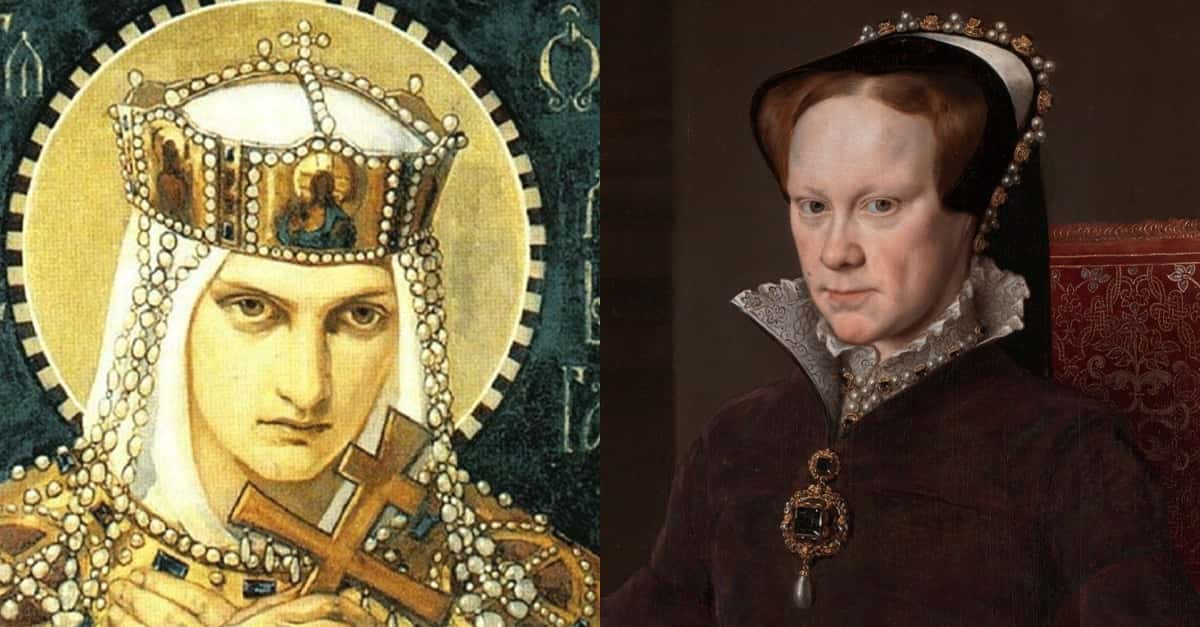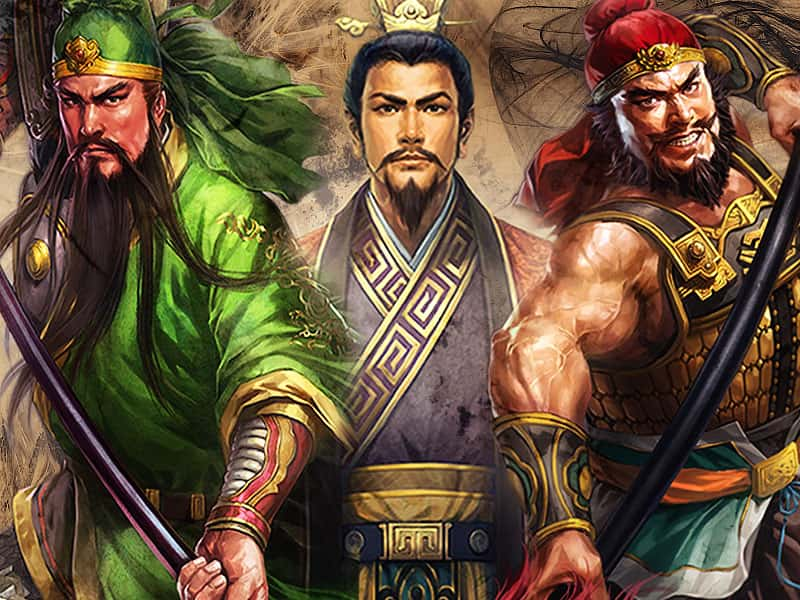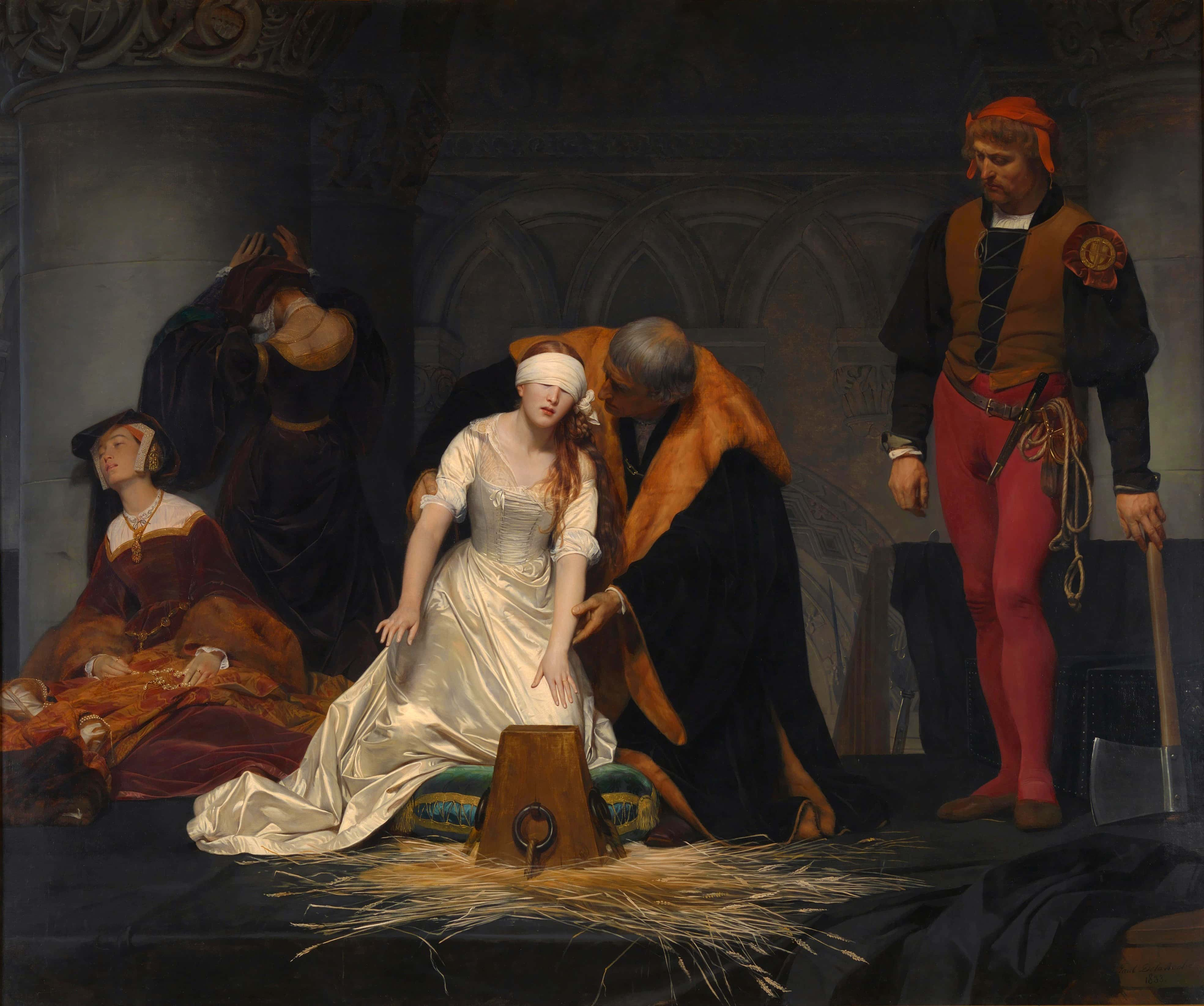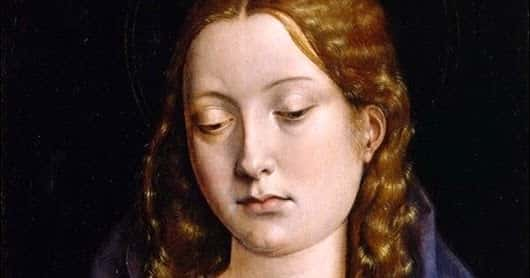Every little girl dreams of becoming a princess, but for these deranged queens, royal life was more like a nightmare than a dream come true. From ruthless betrayals to chilling acts of revenge, queens like Bloody Mary, Joanna the Mad, and Olga of Kiev took "deranged queen" to the next level. Danaerys Targaryen has nothing on these bloodthirsty rulers.
Deranged Queens Facts
Maria the Mad
Queen Maria I of Portugal was known by two different titles: Maria the Pious, and Maria the Mad. Her reign started out pretty smoothly, and the people considered her to be a good ruler—that is, until she became delirious 10 years into her reign in 1786. As we'll see, Maria suffered a number of devastating losses that year. It's no wonder that she was nearly driven insane.
1. I’m Damned!
When Maria became delirious, she started ranting and raving, screaming and crying, and was positive that she was damned. As part of an attempt to cure her of her madness, she was unwillingly subjected to treatments such as bloodletting and enemas. Yeah, like that will stop the shrieking.
2. The Not So Good Doctor
Dr. Francis Willis, the physician of King George III—yes, another mad monarch—was called in to examine Maria, and not surprisingly, he declared her insane. If you thought bloodletting and enemas were nasty, this guy’s treatments made them look like nothing more than taking an Aspirin. He tried straight jacketing, blistering, and ice baths, none of which were terribly pleasant or helpful.
3. Co-Ruler
Is a royal family a real royal family if they don't feature a bunch of in-breeding? Unluckily for Maria, her family seemed to think so. Her husband Pedro was also her uncle...and he was 17 years older than his niece-bride. That sounds like a pretty bad deal, but at the very least, he wasn't interested in government business. He devoted all of his time to hunting and religion, leaving Maria I free to rule.
4. Successive Blows
1788 was a pretty bad year for Maria. Within the space of a few months, her elder son died of smallpox and, followed by her daughter Mariana, her husband, and her newborn son. As if that weren’t enough, Inacio de Sao Caetano—her confessor and closest confidant of more than 30 years—died of a stroke, plunging the Queen into grief.
5. Heavy Conscience
As if the successive deaths of her family members and confessor weren’t enough to drive a person over the edge, Maria also suffered from a condition known as religious mania. She was certain that her father’s soul was eternally damned and suffered from frightening visions of his blackened corpse being tormented in hell. This heavy burden sat on her conscience for over 30 years.
6. All Her Fault
The death of the Queen’s elder son to smallpox was something that she entirely blamed herself for. She could have had him inoculated against the disease when he was young, but she refused on religious grounds, believing that it was against the will of God.
7. Fire and Brimstone
When the medical treatments failed to cure Maria of her mental illness, the Bishop of Algarve was appointed her new confessor. Ultimately, his preaching about hellfire and damnation only ended up making Maria feel worse. His intensity pushed her the rest of the way off the ledge.
8. Mad Woman in the Palace
It would have been a lot easier on everybody had Maria just been able to be locked away somewhere, but she wasn’t. When the court was forced to move to Quelez after the palace burnt down in 1794 (which also probably didn’t help matters with Maria’s sanity), visitors would complain that they heard horrifying screams throughout the palace.

History's most fascinating stories and darkest secrets, delivered to your inbox daily.
9. Taking the Reigns
By 1792, Maria was completely insane and not in any shape to continue ruling. Her son John reluctantly took over running the government but delayed officially accepting a formal regency. He finally took the throne in 1799 for a truly tragic reason: there was no longer any possibility that his mother would ever recover her senses.
Olga of Kiev, The Vengeful Viking Princess
Her name may not pop up in lists of fierce woman in history, but just because her story is obscure doesn’t mean it isn’t fascinating. After her husband died, Olga of Kiev went out for vengeance and became an unstoppable machine. One thing is for certain: this Viking princess definitely earned her terrifying reputation as one of the most bloodthirsty queens in history.
1. Birch Please
The brutal death of Olga's husband Igor kick-starts her transformation from sweet princess to vicious queen. When the enemy Drevlians saw Igor approach, they decided to stop the Russian King in his tracks and kill him in cold blood. The Drevlians didn’t just behead Igor. They tied the King’s legs and feet to bent birch trees, then released the pressure from the trunks. As the trees sprang back into their usual stance, the force tore Igor in half. Ouch.
2. Mom’s Got This
When Olga heard about her husband’s violent death, her profound sense of grief transformed into bloody vengeance. She sprung into action, taking over the kingdom in place of the heir Svyatoslav, who was just three years old. Her reign was off to an utterly terrifying start: Soon after she heard of her husband's heinous death, 20 smug Drevlians rode into town with a chilling offer: Now that Olga was single, wouldn't she like to marry Prince Mal, the same man who killed her beloved husband?
3. Plot Twist
The day after the Drevlians asked Olga to marry her husband’s killer, they returned to court to receive their honors. As Olga had promised, her people began to carry the Drevlians back to their boat as a show of respect. Or at least it seemed like a show of respect until Olga’s forces threw the Drevlians into a trench.
 The Legend of Princess Olga (1984), Dovzhenko Film Studios
The Legend of Princess Olga (1984), Dovzhenko Film Studios
4. Paging Quentin Tarantino
It turned out that the night after Olga heard the Drevlians’ twisted offer, she ordered the people of Kiev to secretly dig an enormous grave for her “honored” guests. As her forces threw the 20 Drevlians into the pit, Olga leaned down and watched her vengeance unfurl. She ordered her people to bury the Drevlians alive.
5. Ice Cold
Legend has it that Olga didn’t just watch the Drevlians’ brutal execution in the pit, she also taunted her husband’s killers. As the dirt rained down on the terrified enemy soldiers, she coolly asked “whether they found the honor to their taste.”
 The Legend of Princess Olga (1984), Dovzhenko Film Studios
The Legend of Princess Olga (1984), Dovzhenko Film Studios
6. Hot Tub
With this batch of the Drevlians dispatched, Olga moved right along, determined to wipe out everyone involved in her husband’s death. She sent a letter to the tribesman who remained at home, urging them to send more men to Kiev to prove that they were serious about the whole marriage thing. Thinking Olga was going to be their new Queen, the Drevlians were happy to oblige.
Olga repaid the favor by locking the new arrivals in a bathhouse and setting it on fire.
7. A Royal Rager
Olga was not one to do things by halves. After massacring two separate groups of Drevlians, she sent yet another letter to the tribe, but this time her plans were a little different. Olga told the tribe to make as much mead as they could—Queen Olga was going to pay them a visit and she wanted to send off her deceased husband in style. When she arrived, she got the Drevlians drunk and then ordered her soldiers to kill them all.
8. The Cogs Turn
In 964, Olga took her fight to Iskorosten, the city where her husband had been so brutally eliminated—only for her luck to run out. Olga’s forces battled the Drevlians for a long, hard year without victory. Even in the face of defeat, Olga refused to back down. She did what she did best: Olga came up with a brilliant plan.
9. Put a Bird on it
Olga sent a peace offering to the Drevlians, claiming that she’d had enough carnage to satisfy her thirst for revenge. But before making it official, she asked for a small favor as a sign of goodwill from the Drevlians. Olga requested three pigeons and three sparrows from each of the city’s houses, even drawing attention to how her tiny request symbolized her merciful nature. Sure, Jan.
10. Burn Baby Burn
Olga was like the MacGyver of misery. You could give her a toothpick and a rabbit and she’d somehow invent the plot of Saw 14—so you can only imagine what she did with the birds. Olga’s army attached pieces of sulfur to the birds and then lit the rocks on fire. When the birds flew to their nests, the smoking sulfur set hundreds of buildings and trees ablaze. In the end, the entire city burned to the ground. And with that, Olga's vicious revenge was finally complete.
Maria Eleonora, The Mad Queen Mother
Not every princess has a fairy tale life. Maria Eleonora of Brandenburg was one of the wealthiest, most eligible, and most beautiful women in Europe when she married King Gustav Adolphus of Sweden—but it was far from happily ever after. From her violent mental deterioration to her private heartbreaks, Maria Eleonora became known forever after as the mad queen mother.
1. Motherhood Changed You
According to historical sources, just a year after Maria Eleonora’s marriage to King Gustav Adolphus in Stockholm, everything changed for the worse. She suffered a miscarriage, and suddenly her jovial demeanor turned jealous, tempestuous, and even at times manic.
2. A Hairy Situation
The birth of Maria’s only surviving child did not go as she planned. When the baby was born, everyone could tell that something was not quite right. It came out covered in dark, downy fleece from its head to its arms. Only its face, arms, and lower legs were bare of the fur. According to the reports, the baby’s nose was also very large—all characteristics that led people to assume it was a boy. It wasn’t. Maria Eleonora had given birth to a very hairy baby girl.
3. It’s a Ghoul!
If King Gustav was slightly disappointed in the sex of his child, Queen Maria Eleonora was torn to pieces. The palace staff even kept the truth from her for several days—but when she found out, it was worse than anyone could have imagined. She reportedly screamed, "Instead of a son, I am given a daughter, dark and ugly, with a great nose and black eyes. Take her from me, I will not have such a monster!"
4. Taking It on the Chin
Maria Eleonora was so crestfallen at her “monstrous” daughter, she may have gone to horrible lengths to punish her. Disturbingly, Princess Christina was alarmingly “accident-prone” as a baby. One time, she somehow tumbled down a full flight of stairs. In another instance, a beam fell into her cradle, and she was even once dropped on a stone floor, which permanently deformed her shoulder.
5. Paint It Black
When Maria Eleonora’s husband passed away, her mourning pushed her already fragile mental state to the breaking point. Wracked with grief, the queen mother had to make sure everyone else was miserable too—especially her hated daughter Christina. For a full year, Maria Eleonora tormented her with a brutal punishment. She forced Christina into blacked-out, darkened rooms to mourn her father in solitude for unforgivably long periods of time.
6. A Macabre Memento
Everyone mourns in their own way, but Maria Eleonora’s way of mourning King Gustav was hella freaky. Not only did she force the young Christina into darkened rooms, but she also reportedly hung King Gustav’s heart in a golden casket on the ceiling above Christina’s bed. She made the girl sleep directly underneath her father’s “blessed” remains.
Take note: That’s not one way to raise a well-adjusted child.
7. Cry Me a River
The queen did not respond well to her husband’s death. She reportedly wept almost continuously for actual years after hearing the news. She also reportedly refused to allow his body to be buried, and would regularly visit it. After 18 months, the Swedish Chancellor stepped in and had him buried.
8. Damage Control
In 1636, Maria Eleonora was so out of her mind, the government separated her from Christina and “placed” (by which I mean, politely imprisoned) her in Gripsholm castle, hoping she couldn’t do anyone any harm there. After a few escape attempts and the devastating news that her detested daughter Christina had given up the crown, Maria Eleonora died, heartbroken, at 55 years old.
Empress Wu Zetian, China's Vicious Ruler
Empress Wu Zetian was China’s sole female ruler, but her rise would fit in perfectly on Game of Thrones. She started as a concubine of Emperor Gaozong, and eventually gave birth to his child. When the baby died soon after, Wu blamed its death on the reigning empress consort, Empress Wang. But that may not be the full story: disturbingly, some historians believe that Wu strangled the child herself.
1. Vicious Cycle
Wu has become infamous in the (male) annals of history as a cunning, ruthless woman, especially after she shoved aside her children and declared herself Empress in 690, founding her short-lived "Zhou Dynasty." One source described her as hated by “gods and men alike," which really sums up how much people despised her.
2. Guess Again
Over the years, Wu became a concubine of Emperor Taizong, which sounds like a high-profile gig...until you remember that it came with some pretty intense conditions. Custom decreed that Wu should retire to a Buddhist nunnery upon the Emperor's death. However, when that day came, Wu refused to give up her power so easily.
3. Snatch That Rising Son
Wu Zetian had other plans that went far beyond hiding out in a convent for the rest of her days. Instead, she stayed at court by attaching herself—politically and romantically—to the newly crowned Emperor Gaozong, aka her own pseudo-stepson! The unlikely couple went on to have multiple children, and Wu even claimed the throne of China for herself after Gaozong’s death.
4. Equality
Emperors were known for having numerous concubines, some of whom performed intimate duties. However, Empress Wu, not to be outdone by the boys, also had her own concubines. The Zhang Brothers were her favorites, and were known to spend a lot of time with Wu in “closed quarters" well into her old age.
5. Tough Customer
While bad press and sexist comments followed Wu's reign from the get go, the most terrifying stories about the Empress are actually true. Wu was reportedly behind the deaths of 36 senior bureaucrats who were either executed or forced to commit suicide. Additionally, hundreds of members of the bureaucrats’ families were enslaved. Yeah, we don't like bureaucrats too, but was that really necessary, Zetian?
6. Initiative
Wu always found ways to stand out as one of Emperor Taizong’s concubines. One of her most notable strategies was offering to tame one of his horses. Her tools? An iron whip, a hammer, and a knife. As she said, “First I’ll beat it with the iron whip. If it does not yield, I’ll hit it with the hammer. If it still won’t be tamed, I’ll cut its throat with the knife.”

Empress Anna of Russia, The Ultimate Deranged Queen
Even as a little girl, the bloodthirsty Empress Anna of Russia was an avid hunter. She reportedly kept a rifle by her window just so she could pick it up and blast away at the birds on her lawn. On other days, she got servants to unleash wild animals in the royal park so she could hunt them down. And that's just the beginning of this deranged queen's violent streak.
1. A Game of Chicken
In order to discipline her most hated courtier, Prince Mikhail Golitsyn, Anna forced him to become the court jester. But not just any court jester. Get this: Poor Prince Mikhail had to pretend to be a chicken for the Empress’ pleasure. She had him sit in a nest within her reception room, and whenever anyone came to visit, he had to pretend to lay eggs.
2. The Prince and the Pauper
For some reason, Anna had something major against Prince Mikhail Golitsyn, and she once let him know it in an absolutely brutal way. Like, worse than the chicken thing. One day, she forced him to marry her attendant Avdotya Buzheninova, mostly because she was a lower-class, older maid, and reportedly not a looker. Oh, but that was just the beginning of the nightmare.
3. Gee, Thanks
Anna gave the Prince and his new bride a lavish wedding—but it came with a cruel twist. Our girl Anna constructed an entire ice palace for their wedding night, complete with ice beds, chairs, and an ice fireplace. Cool, huh? Except then she forced them to sleep there. On an extremely cold night. In the middle of winter. In Russia.
Just before shutting the Prince and the maid in to face their fates, Anna reportedly advised them to get doing the dirty if they wanted to keep warm enough to stay alive.
4. It’s a Circus Out There
On the way to their pleasant little ice palace, Anna also forced Prince Mikhail and Avdotya to sit in a cage, dressed as clowns, on top of an elephant. She then paraded them through the streets of St. Petersburg so crowds could laugh and jeer at the couple. Forget passive-aggressive, this is just straight-up psychotic. Oh, and what was Mikhail's reward after all Anna's ice-cold shenanigans? His new bride Avdotya died of pneumonia a few days after their wedding night.
Joanna of Castile, The Betrayed Queen
Queen Joanna of Castile didn’t become known as “Juana La Loca” for her sound and righteous rule. Yet to what extent was this “mad” Spanish queen simply a victim of bad luck and greed? As a vulnerable female heir to a rich country, Queen Joanna was surrounded by male relatives who had much to gain from her loss of power.
1. Faith Shouldn’t Hurt
I imagine it’s hard to catch a break when your mom literally engineered the Spanish Inquisition. According to some sources, Queen Isabella was deeply enraged by Princess Joanna’s insufficient piety. It’s been suggested Isabella “corrected” her daughter’s religious disposition with literal torture methods such as “La cuerda,” where Joanna was hung in the air by ropes and weighted down by her feet.
We can’t imagine that felt great—either for Joanna’s body or her mental health.
2. Match Made in Heaven or Hell?
When she was just 17 years old, Joanna was formally engaged to Philip of Flanders (future Duke Philip I of Burgundy), who was the son of the Holy Roman Emperor Maximillian I. Most noblewomen had very little say in their husbands—but luckily for Joanna, her fiancé was only a year older than her and already known as “Philip the Fair” for his hot looks.
3. Not Enough Room in This Bed for All of Us
Joanna’s marriage to Philip was one of mutual but lopsided passion. Joanna worshipped him; Philip found Joanna beautiful and charming, but not worth staying faithful to. Her Burgundian beau quickly began to see other ladies on the side. His infidelities often sent Joanna into jealous rages and depressive tailspins—and as we'll see, they were the least of his betrayals.
4. Swipe Left at the Boiling Cauldron
Joanna of Castile was ready to fight for her man—at any cost. According to some legends, she even indulged in “love potions” and other supernatural snake oils to keep her husband’s interests. Philip, a classic Renaissance man, was not turned on by witchcraft, and simply continued having his many extramarital affairs.
5. Going out for a Pack of Smokes…
Some men can’t handle their wives making more: the pressure of being Castile’s heir and future Queen put a strain on Joanna’s marriage to Philip of Burgundy. He had moved his court to be with Joanna in Castile as the country’s heirs, but their arguments intensified until he eventually left Joanna pregnant and alone in Madrid.
6. Time to Unwind
As you might expect, Joanna did not take Philip's abandonment very well at all. In a dark omen of things to come, she fell mentally and physically apart when he left: The heiress indulged in the rather unroyal conduct of crying herself to sleep every night, refusing lavish meals, and flinging her royal body against the walls.
7. I Hope This Doesn’t Become a Habit…
Joanna frantically wished to follow her husband, who had retreated to his home in Flanders. Unfortunately, her mother Queen Isabella strictly forbade it, and had Joanna sequestered to her rooms in the Castle La Mota at Medina del Campo. It was there she continued her mental breakdown—and things took an even darker turn. She began pacing all day, babbling in tongues, and still denied herself food and sleep.
Of course, there's another, darker side to her madness that we'll get to later...
8. Too Much off the Top
During Joanna's period of abandonment with Philip, her mother eventually allowed her to follow him back to Flanders. She arrived home to the worst possible sight: Philip had taken an in-house mistress. Not one to be usurped without a fight, Joanna allegedly started hacking off her rival’s hair with scissors. When this act of violence failed to heal Joanna’s heart, she simply stabbed the woman in the face.
9. Here Lies One Dead Bro
The pivotal tragedy of Joanna’s life occurred in 1506: her beloved Philip died suddenly at the tragically young (but still beautiful) age of 28. The cause of his untimely death was ostensibly typhoid fever…but it was believed by many—including a very paranoid Queen Joanna, reportedly—to be the result of poison.
10. A Matter of New Life and Death
When her beloved (and traitorous) husband Philip died, Queen Joanna didn't just grieve in the normal way; in fact, it sent her into her worst emotional tailspin yet. For a considerable period, she refused to leave her husband’s already-embalmed body. During this time, she was pregnant with their final child, Catherine.
11. Eternally Hers
Joanna’s jealousy over Philip’s love also continued after his death. While “accompanied” by her late husband’s casket, it’s rumored that Joanna would only travel at night. After all, she didn’t want other women tempting Philip of Burgundy’s corpse during those sexy daytime hours. Her entourage avoided nunneries for this reason—you can never be too careful, even around holy sisters.
12. You’ll Always Be With Me
For the most part, Joanna had the sense to keep her husband’s casket closed. It was simply transported to be with her at meals and her bedside. She only occasionally opened it to gaze upon her beloved’s pretty (and rapidly decomposing) face. Only years later was Philip finally laid to rest again. Of course, this was apparently right outside of Joanna’s window, where his notorious eye could wander no more.
13. No One Likes a Chatterbox
In her final years, a paranoid Joanna even accused a group of nuns of trying to kill her. As the queen’s mental and physical state continued to deteriorate to levels still unknown and unmeasured today, her son King Charles simply told her keepers to limit his mother’s conversations with other people, “for no good could come from it.”
14. I’m Big Enough to Say, “She’s Crazy”
Joanna's insanity, however, has an even darker and more personal side: Recent scholarship has suggested Joanna’s own beloved husband and father spread the rumors of Joanna's “insanity.” While Joanna’s real behavior hardly helped, the ambitious men had incentive to make people think Joanna was an incapable ruler. Both wanted to usurp her authority.
Olympias: Queen, Mother, Baller
Although most people remember her as the queen of Philip II of Macedon or the mother of Alexander the Great, Olympias' bloodthirsty reign is more than enough to land her in the annals of history all on her own. From fighting for her son to doing anything to wrest power away from her rivals, Olympias took beauty and bloodshed to the next level.
 Alexander (2004), Warner Bros.
Alexander (2004), Warner Bros.
1. The Family Black Sheep
Olympias would do anything to support her son Alexander's quest for power, and given his reputation, it's clear that she succeeded. In fact, most people don't even realize that Alexander wasn't actually his father's eldest son. Alexander's competition was Arrhidaeus, who was Philip II's son with another one of the Macedonian king's many wives. So why didn't Arrhidaeus claim the throne? The dark answer has everything to do with Olympias...
2. He Doesn’t Like Her, Does He?
One reason why Arrhidaeus wasn’t considered the heir to Philip II was that, depending on which historian you read, he either had a learning disability, or he was completely mentally deficient. According to the historian Plutarch, this disability was due to a poisoning attempt by Olympias, who was jealous of the boy and wanted her son to be the heir.
3. Mom, Dad, Stop Fighting Please
Philip II and Olympias had an apocalyptically bad relationship as the years went on. Philip II was known for his parties, affairs, and hot-blooded disposition, while Olympias had a reputation for being very jealous and ambitious. In other words, it was a marriage made in hell. These tensions would hit fever pitch on the dark day of King Philip's assassination.

4. Murderess?
One of the most consistent stories surrounding Olympias’ legacy is that she was somehow behind the assassination of her husband, Philip II. But that's not even the most chilling part: Rumors swirled that Olympias honored the corpse of Philip II’s killer, even after her own son ordered the body to be crucified as a symbolic punishment. Yikes.
 Alexander (2004), Warner Bros.
Alexander (2004), Warner Bros.
5. Cold-Blooded
After Philip died and before Alexander the Great rose to power, Olympias had to do a lot of work to see her son on the throne. For one, Philip's seventh wife Eurydice and her children still posed a big threat to Alexander's supremacy. Willing to go any lengths for her beloved Alexander, Olympias plotted a brutal revenge. She had Eurydice's children killed, and the horrific act then caused Eurydice to commit suicide.
An alternate version of the events claims that Olympias ordered both the queen and her children killed—but is that much better?
 Alexander (2004), Warner Bros.
Alexander (2004), Warner Bros.
6. Hands Off, Peasants
After a series of battles and conflicts, Olympias finally surrendered to her old enemy, the "Kingslayer" Cassander. But when Cassander ordered his soldiers to kill her, he was in for the surprise of his life. Such was the prestige of the queen and her son Alexander’s memory that the Macedonian soldiers refused to lay a hand on her. Undaunted, Cassander came up with an utterly heinous idea.
7. These Violent Delights Have Violent Ends
Cassander decided that if the Macedonian soldiers wouldn't take Olympias out, he'd finally someone who would. He turned to the families of all those people that Olympias had killed over the years and told them that they could finally take a shot at the woman who ruined their lives. Only too happy to take revenge, they took the aging queen and publicly stoned her to death.
To add insult to brutal injury, Cassander denied Olympias’ corpse a proper burial. Olympias was 59 at the time of her death.
Catherine de Medici, The Deadly Queen Mother
Catherine de Medici has gone down in history as a brutal Machiavellian matriarch whose ambition eclipsed her children’s happinesss. Scandal followed Catherine throughout her tumultuous life from her untimely birth to her reign as a fertility-challenged princess of France and her tenure as a bloodthirsty mother thrust into religious conflict.
1. Room with a View
It’s said that Catherine went to disturbing lengths to keep an eye on her husband's illicit activities. She may have bored peep holes into the roof of his mistress Diane de Poitiers’s bedchamber so that she could see her husband “in action." Catherine apparently noted the contrast between the disinterested performance she got from Henri versus the “spectacle” he gave Diane…
2. Mommy Massacre
The Bartholomew’s Day Massacre is one of history's bloodiest days...and many people lay the blame firmly at Catherine's noble feet. After some Protestants attempted to murder an important admiral, the story goes that Catherine licensed the massacre as revenge. The violence snowballed for a long, blood-soaked week, claiming the lives of innocent bystanders before it spread into the French countryside and persisted, purge-like, well into the autumn.
 continuing counter reformation
continuing counter reformation
3. Corporal Punishment at the French Court
When Catherine’s youngest daughter Marguerite, was found to be having an affair with Henry of Guise, Catherine and her son Charles IX went to chilling lengths to show their disapproval. They allegedly had the princess pulled from her bed, her nightclothes ripped, and her hair torn from her head as punishment. Yowch.
4. The Worst Third Wheel
Catherine's life featured way too much trauma, but nothing compares to this. On October 2 1533, she married the french Dauphin Henri. The couple were lucky to be the same age—just 14 years old—but old men still wormed their way into the honeymoon. Henri’s father, King Francis I, apparently stayed in the bedroom until the marriage was fully consummated. Yick.
Bloody Mary and her Tithe of Troubles
Although she only reigned for five short years, King Henry VIII's first-born daughter Mary was a busy Queen. As she attempted to reverse the Protestant reforms of her father, Mary had over 280 dissenters of the Catholic Church burned at the stake. Her brutal actions earned her a terrifying nickname. To this day, she's known as "Bloody Mary."
 thissideofthetruth - WordPress
thissideofthetruth - WordPress
1. Devoted Husband
In the summer of 1554, the English court was bracing for news of Mary’s first child. Mary started to show signs of a pregnancy months earlier, and everyone was taking precautions for the next heir to the throne. Her husband King Philip was possibly even planning to marry Mary’s half-sister Elizabeth in the event that his wife died (he was a stand-up guy). There was just one problem...
2. False Alarm
Mary wasn’t actually pregnant at all. Perhaps for psychological reasons, she had a rare case of false pregnancy. Tragically, it would not even be her last. During one these episodes, Mary was so convinced that she was with child that she had letters drafted announcing the birth of her heir. They would never be needed.
3. Out of the Will
When Mary's brother Edward passed away, she should have ascended to the throne. But thanks to Duke John Dudley, everything went wrong. On Edward's deathbed, Dudley convinced the King that his daughter-in-law Lady Jane Grey would be a better Queen than Mary. He sealed the deal by reminding Edward that Jane would keep the country Protestant while Mary would try to bring back Catholicism. Dudley wasn't wrong...but he was still making a deadly mistake.
4. Tough Decisions
Dudley's plot didn't work out, as Lady Jane was infamously Queen for only nine days. After Mary took the throne in 1553, she had John Dudley immediately executed for high treason, but faced a tough decision when it came to Lady Jane and her husband, Guildford Dudley. Mary knew that Jane was just a political pawn, so even though she was guilty of treason, Mary didn't want to execute her.
However, just as everything seemed to be settling, tensions arose and Mary was forced to destroy Jane. She did so in grim fashion: public beheading.
5. Vengeance for My Mother
Mary didn't exactly shy away from executions, but one death sentence was more personal than all the rest. Mary was directly involved with the arrest and execution of the Archbishop of Canterbury, Thomas Cranmer. If that name sounds familiar, it's because Cranmer was the one who declared the marriage between Henry VIII and Catherine of Aragon (Mary's mother) invalid. Mary clearly never let that go. Even though Cranmer recanted his Protestant beliefs, she executed him anyway.
 atpaperjfrl.automator.me
atpaperjfrl.automator.me
6. Death Comes for the Queen
Mary died, childless, in 1558 during an influenza epidemic. However, the reasons for Bloody Queen Mary’s death are not totally clear, even to this day. Some accounts suggest that she succumbed to the influenza outbreak, while others imply that she died of cancer. All her false pregnancies may have actually been the result of a tumor.

Catherine of Aragon, Henry VIII's Chilling First Bride
Catherine of Aragon was Henry VIII’s first wife and his longest-lasting Queen Consort of England. One might remember her as the dark, pious lady whom Henry “divorces” so that he can marry Anne Boleyn. But there's so much more to Catherine than her status as the ultimate spurned woman in history. She was also a fierce warrior, a disturbed young woman, and an eternally doomed mother.
1. Watch the Queen Conquer
In 1513, a heavily pregnant Catherine rode in full armor to address troops at the Battle of Flodden. Henry was away at a foreign war, leaving Catherine as regent. The Scottish army, led by Henry’s brother-in-law King James IV, took advantage of his absence and tried to attack the kingless nation. They didn't know it yet, but that was one heck of a bad call.
2. My Bloody Bro-in-Law Valentine
Catherine utterly destroyed the Scots, but her victory wasn't complete without a brutal send off. She took a bloody piece of James’s coat for Henry to use as a war banner. She had wanted to send her hubby his brother-in-law’s body itself, but that was too much for those weak-bellied Englishmen—her words. Remember, this bloodshed was during her and Henry's happy days!
3. Phantom Fetus
Catherine had an absolutely brutal time when it came to motherhood, but nothing compared to the child who “disappeared.” Kind of. In January 1510, she suffered her first of many miscarriages. However, her stomach remained puffy, probably from infection, which caused her doctors to believe that she had been carrying twins and one had survived, even as Catherine continued to menstruate—prenatal care was…experimental in 1510. Two months later, Catherine went into seclusion for the birth. But of course, no child arrived.
4. Woe Is Womb
Why did so many of Catherine’s pregnancies fail? In recent years, some thinkers have put forth a theory that Catherine suffered from anorexia. During her young widowhood, uncertainty and poverty made Catherine frequently ill and depressed. This physical trauma may have led to future fertility problems. Sounds like a stretch, but it’s worth noting yet another terrible thing that happened to Catherine of Aragon.
5. Bummer Ending
Life as a divorcée was not kind to Catherine. After she and Henry VIII split, Catherine refused to be kind to herself, at least physically. In her last months, the ex-queen was isolated in Kimbolton Castle, where she fasted constantly and wore nothing but a hair shirt from the Order of St. Francis. It was prickly living but demonstrated Catherine’s commitment to arguably the last thing she could count on, that being her Catholic faith.
6. Girl Gang
Throughout the "Great Matter" (England's name for the kerfuffle about Henry's divorce), Catherine’s popularity with women was huge. A Venetian diplomat claimed that an angry mob of “seven to eight thousand women” tried to seize and kill Anne Boleyn in Catherine’s name. Of course, this story has raised suspicion in recent years, but the tall tale’s popularity testifies to Catherine’s appeal as the “spurned woman” against Anne’s “other woman.” They were the Jen and Angelina of their time!
Queen Maria Theresa, The Last Unhinged Habsburg
Queen Maria Theresa was literally a natural-born leader. As the eldest surviving child of a Holy Roman Emperor, the swaddling babe held more power in her pinkie finger than most can dream of in their entire lives—and she fought tooth and nail to keep it. After all, that was just the beginning of a legendary reign full of violence, tragedy, and lots and lots of children.
1. Boy, Bye
Maria Theresa's husband Francis I was about as good of a ruler as he was a spouse. Though he had a brilliant mind for business, statecraft was not his forte, and it suited both partners just fine to have Maria Theresa take the reins on the reign. She inhabited the role with ease. Apparently, if she and Francis disagreed in council meetings, she would just dismiss him from the room. Sounds about right.
2. Get out
Devout Catholic monarchs don’t have the best track record for “tolerance” or things like “not burning people at the stake” (ahem, Bloody Mary), and Maria Theresa was no different. In what most rightly consider the darkest part of her reign, she persecuted and expelled Jewish people from all across her realm, tempering these edicts only slightly in her old age.
It’s easy to throw up our hands and say, “Those were just the times,” but the thing is, they weren’t. Even her own son Joseph found her policies "unjust, impious, impossible, harmful and ridiculous.” Check, check, check.
3. Campaign Manager
Maria Theresa knew she wanted to follow in her father’s footsteps and become Holy Roman Empress—but there was just one problem. No woman could be elected to the post. Then again, she did have a perfectly good husband lying around. After five long years, Maria Theresa finally succeeded in electing Francis to Holy Roman Emperor in 1745. She basically reigned through her sitting duck hubby.
4. Maria’s Choice
On September 11, 1741, the rebel queen performed an absolutely baller move. She appeared at the Hungarian Diet wearing the nation's glorious Crown of Stephen. The coronal is also known as “The Holy Crown of Hungary,” and Maria Theresa wore it as if to say, “Yeah guys, like it or not, I AM your Queen.” But she wasn’t even done yet.
When the crowd turned on her, she held up her newborn son Joseph, wept, and pledged him to their cause. Though I don’t really recommend throwing your tiny baby under the bus at important political meetings, it worked for her. By the end, the Hungarians vowed to die for her.
5. Take It Down a Notch
Throughout Marie Antoinette’s reign as Queen of France, Maria Theresa never let her daughter get too cocky. She kept up a weekly correspondence with the girl, where she often berated her laziness, frivolous spending, and especially her slow start in producing heirs. I mean, she's not totally off base but is it really too much to ask for some constructive criticism?
6. A Rash of Bad Luck
Here’s family drama for you: It’s said that Maria Theresa killed her own daughter. In 1767, Maria Theresa’s daughter-in-law died of smallpox. The Empress then forced her 16-year-old natural daughter Maria Josepha to pray at the badly-sealed crypt. Two days later, the worst happened. The teenage girl showed the tell-tale smallpox rash and quickly died.
7. Forgive Me
Maria Theresa, like many others, blamed herself for the tragic death of Maria Josepha—but the truth is much more complicated. The incubation period for smallpox is actually about one week. Since Maria Josepha showed the rash just two days after visiting the crypt, she had to have contracted it before then. Maria Theresa’s anguish was in vain.
Their Darkest Moments
For its time, Catherine’s cause of death was ambiguous. Her embalmer noticed the corpse was in perfect health—save for her heart, which had turned black. That led some people to whisper about poison. Today, historians generally agree that Catherine died of heart cancer, which—considering the circumstances of her life—appears too poetic to be true.
1. New Challengers
In her later years, Olympias was surrounded by enemies. One of her more formidable foes turned out to be her stepson Arrhdiaeus, the very same man she was rumored to have poisoned and disabled. You see, Arrhdiaeus had married a very ambitious woman named Adea Eurydice, who wasted no time declaring herself Queen of Macedon in Olympias' place.
2. The Tide Turns Again
The upstart queen Adea Eurydice brought her armies to the door of Olympias and her allies. It did not work well for the young usurper: When the Macedonian soldiers realized that they were going to have to fight the mother of their former king, they simply refused to fight. Without missing a beat, Olympias captured the woman along with her husband.
3. Be Ruthless
With the capture of her stepson and his ambitious wife, Olympias was not merciful in her victory. She executed Arrhidaeus in a straightforward manner in order to be rid of him—but Adea Eurydice suffered a much darker fate. Olympias famously sent her a cup of poison, a noose, and a sword, telling her to choose how she would die.
According to the histories, Adea Eurydice chose to hang herself, though she cursed Olympias to the very end of her life.
4. Together Forever and Ever and Ever…
The widowed Joanna of Castile couldn't even accept her husband Philip's mortality after he was buried and in the ground (at her father's insistence). Shortly after his death, she reportedly ordered his body to be exhumed, had the casket opened, jumped to his side once again, and kissed his dearly departed feet. From this point, wherever Joanna went, so did Philip’s casket.
5. Don't Mess With Wu
When one of Wu Zetian's ministers advised her that she should live a more respectable life as a widow rather than an empress, her response was so disturbing that it’s impossible to ever forget. Zetian was not a woman to be messed with. She promptly sentenced him to exile in the “swampy, disease-ridden Southland” where one can imagine that the minister didn't have a happy ending.
Sources: 1, 2, 3, 4, 5, 6, 7, 8, 9, 10, 11, 12, 13, 14, 15, 16, 17, 18, 19, 20, 21, 22, 23, 24, 25, 26, 27, 28, 29, 30, 31, 32, 33, 34, 35, 36, 37, 38, 39, 40, 41, 42, 43, 44, 45, 46, 47, 48, 49, 50, 51, 52, 53, 54, 55, 56, 57, 58, 59, 60, 61, 62, 63, 64, 65, 66, 67, 68, 69, 70, 71, 72, 73, 74, 75, 76, 77, 78, 79, 80, 81, 82, 83, 84, 85, 86, 87, 88, 89, 90, 91, 92, 93, 94, 95, 96, 97































































































